Harvesting rhubarb and knowing when the rhubarb is ripe enough to pick, is a skill any home grower of this unusual perennial vegetable needs to be able to successfully enjoy rhubarb’s tart flavors.
This post may contain affiliate links at no additional cost to you. By making your purchases through the links on this website, IMSL may make a small percentage at no direct cost to you. IMSL only promotes products we use & truly believe in. Please refer to my Privacy & Disclosures for further information. IMSL thanks you for your support!
RHUBARB DEFINED
Rhubarb is a vegetable? Yup. Go figure. It’s also a perennial one, meaning that it grow’s year-to-year all on it’s lonesome self. That translates into FREE food! Y’all know how I love FREE 😊
Rhubarb has made its presence known around the globe, originating in Asia, making its way to Europe in the 1600’s, and arriving in America shortly after.
Rhubarb’s stalks are the only edible portion of the plant. In fact, the leaves of the rhubarb plant are actually toxic as they contain an irritant known as oxalic acid, an organic compound found in many plants.
Rhubarb is probably most known for its tart contribution to jams (strawberry/rhubarb jam anyone?), pies, and other sweetened fruit products. One of my favorites is to add frozen rhubarb to strawberry rhubarb muffins. Yummy! And did I mention juice? Yup!! Find out how to make your own refreshingly delicious rhubarb juice concentrate and how to enjoy it by clicking the you know what 😊
HOW TO GROW RHUBARB
Rhubarb is the easiest perennial plant (one that comes back every year) I have in my garden. I literally do nothing to this plant and it grow’s well year-to-year. Well, almost nothing.
RHUBARB GROWTH HABIT
Maybe the most important tip I can share with new growers of rhubarb is to pick your placement of the plant carefully. Rhubarb does not like to be moved. No way, no how. So pick your site for planting carefully, taking into consideration a few points found below.
Rhubarb grows large and needs room to grow. A medium sized rhubarb plant can extend to 4 feet in diameter and only gets larger. Definitely plan on this when choosing its home.
RHUBARB GROWING CONDITIONS
Rhubarb appreciates a rich, well-draining soil (rhubarb does not appreciate soggy roots) in full sun (at least 6 hours of direct sunlight) conditions as far south as zone 7. In hotter zones (USDA hardiness zone 6 and higher), its wise to plant rhubarb in an area where it can be shaded from hot afternoon sun.
Not in these gardening zone areas? No worries. Think about growing this unique perennial from seed as a winter annual 😊
Rhubarb loves a cold dormant period and grows best where the ground freezes. In order for rhubarb to produce full, thick stalks, it needs that dormancy period each year. Thus, it loves our New England weather and is common in many home gardens.
RHUBARB’S WATERING NEEDS
Rhubarb also appreciates consistent moisture, but is somewhat drought tolerant when reaching a mature stage such as mine. I have to admit, I hardly ever water my rhubarb plant and it still grows and survives.
That being said, plan to consistently water (once the top inch of soil dries out) during the first two years of growing, and adding plenty of organic matter during these first two years as well, as it loves rich, organic soil.
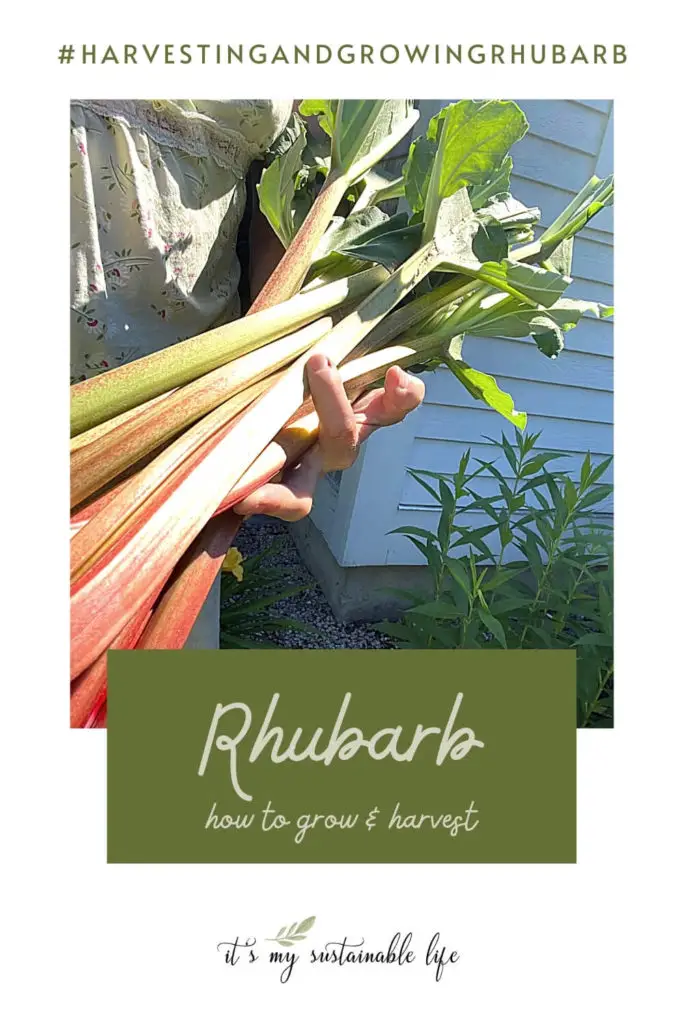
BEST TIME TO PLANT RHUBARB
Although rhubarb can be grown from seed, it’s much easier to grow from the crowns of divided plants that are at least a year old. So I do suggest, find a friend, neighbor or local farmer who would be willing to share a few with you.
The best time to plant your crowns? It’s best to plant your rhubarb budded pieces in either the autumn or spring as the soil is moist and warm.
RHUBARB ISSUES – PESTS & DISEASES
There are very few issues that can result in harm to your rhubarb plant. Pests and diseases are extremely rare, especially if you have met the above criteria when growing it yourself.
That being said, every plant has the potential for some issues, and rhubarb is no different. The Stark Bro’s have a great short , complete list of rhubarb’s potential diseases and pests should you be in need of advice in that area.

The biggest two issues that I’ve found? Crown rot and a beetle known as Rhubarb curculio. Fortunately, both of which have not been an issue here on the hill.
Once you have your rhubarb growing for several years, you can then begin to harvest and reap the rewards of your hard work.
HARVESTING RHUBARB
Harvesting rhubarb could not be easier to do. I’ve gone ahead and made a short video for all you visual learners out there. Otherwise, read on for some great tips and guidelines for harvesting from your established rhubarb plants.
WHEN TO BEGIN HARVESTING RHUBARB
Probably one of the most important guidelines to follow for harvesting rhubarb is knowing when to safely harvest it.
Why does this matter? It matters to your plant. By harvesting only during specified times, the energy is directed back to the plant itself, allowing it to gain strength and be supported throughout its dormant period.
The rhubarb harvest period runs typically for an 8-10 week period. Here in the NE, that means from May through June here on the hill. Thereafter, let it be, strengthening itself for the coming winter months. Not to mention, rhubarb tends to become a bit more fibrous or tough as the summer progresses.
RHUBARB HARVESTING – AGE MATTERS
Age of the rhubarb plant matters when it comes to harvesting. It’s not recommended to harvest any rhubarb stalks during its first year of growth. Personally, I would allow two years growth before harvesting any stalks, and then take sparingly. Patience is key here. Allow those plants to be fully established before taking any from it.
Typically, after 3 years of growth, your rhubarb is ready to be fully harvested. A good rule of thumb come the 3rd year is to plan on taking no more than 1/3 of the plant. Thereafter, go ahead and harvest away, leaving only the smaller stalks to continue to grow.
HOW TO TELL IF RHUBARB IS RIPE
How do you know when your rhubarb is ripe enough to harvest? Do not go by color or the stalks! The color variations of rhubarb, green, reds, or a combination of both, largely depends on the rhubarb variety and is not an indication of its ripeness.
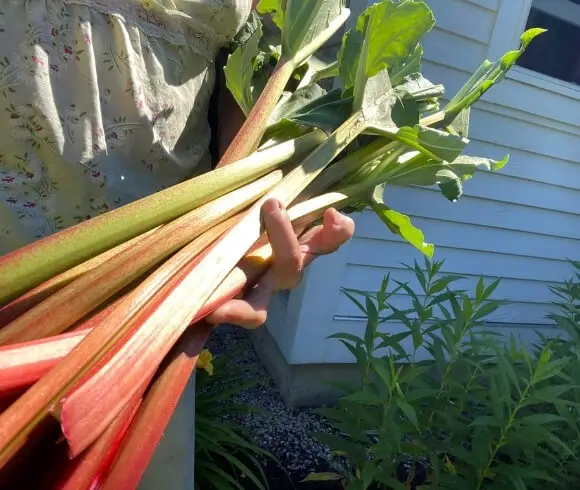
Instead of color, go by the size of the stalk itself. You can be sure it’s ready to be harvested if the stalk is anywhere between 7 to 15 inches in length and the leaves are fully developed.
CAN YOU CONTINUE TO HARVEST RHUBARB AFTER IT FLOWERS
Rhubarb plants will produce large flowering stalks come mid-summer. These flowering stalks will produce seed for future rhubarb plants. Unless you are looking to save rhubarb seed for some reason, these flower stalks should be removed.
Seed stalks take a lot of energy from the plant itself, can reduce your plants vigorous growth next year, and are of no use other than for seed. They are not edible nor can they be used in any way.
Should your plant produce a flowering stalk, it by no means effects the edible stems of the rest of the plant.
Can you continue to harvest the stalks? Yes. Should you? If you are following the recommended time frame for safely harvesting rhubarb, best not.
WHEN TO END HARVESTING RHUBARB
Just as important as knowing when you can begin to harvest your rhubarb, it’s just as important to know when to end harvesting it.
As you can harvest during any time of its growing season, even right into fall, realizing that your plant needs a “down” time or timeout in order to regather its strength for next year’s growth is vital to a healthy rhubarb plant. One that will keep on giving year-to-year.
So I cannot stress this point enough. Follow the guidelines of starting your harvest when those stalks reach their mature state (between 7-15 inches in length) and stop harvesting come the end of June to the beginning of July.
HOW TO HARVEST RHUBARB
Although technically there are two ways of harvesting your rhubarb, cutting or pull & twist, the pull & twist method is by far my preferred and recommended method.
HARVESTING RHUBARB WITH A KNIFE
Why don’t I like the knife method? Cutting with a knife always leaves a bit of the stem left on the plant itself. It does not signal to the rhubarb plant to reproduce another stem in my opinion.
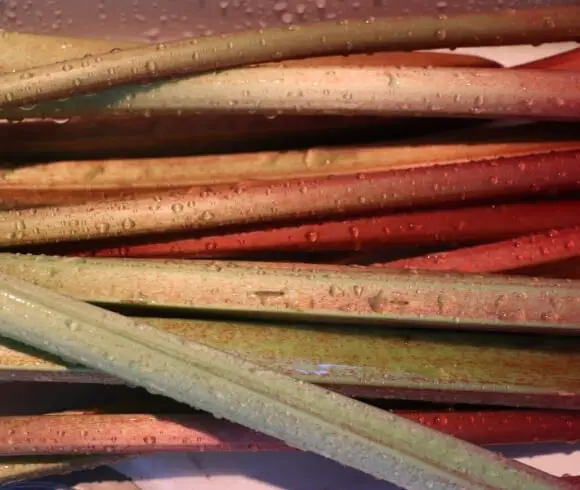
I have had better success with the pull & twist method for doing just that. Promoting future growth of the plant.
HARVESTING RHUBARB WITH THE TWIST & PULL METHOD
By pulling the rhubarb stalk gently side-to-side and twisting it off, removes the entire stem from the base of the plant itself. I feel this is what signals the plant to reproduce & grow further stems, thus creating a full and healthy plant.
To harvest rhubarb using the twist and pull method simply do the following:
NOTE: I encourage you to start harvesting the outer stalks and work your way in. They are easier to harvest using the pull & twist method due to the growth habit of the plant.
- GRAB LOW – Follow a mature stalk down to the base of the plant & grab the stalk firmly
- PULL SIDE-TO-SIDE – Gently begin to move the stalk side-to-side and away from the plant
- TWIST OFF – Gently but firmly twist away from the plant and pull it up at the same time
- USE YOUR EARS – You will hear a faint “pop” as the stalk is released from the plant itself.
This action of twisting & pulling is a gentle one. If it doesn’t come away, you can try pulling it to the other side. If all else fails, remove the stalk using a sharp knife as low as possible to the root base of the plant.
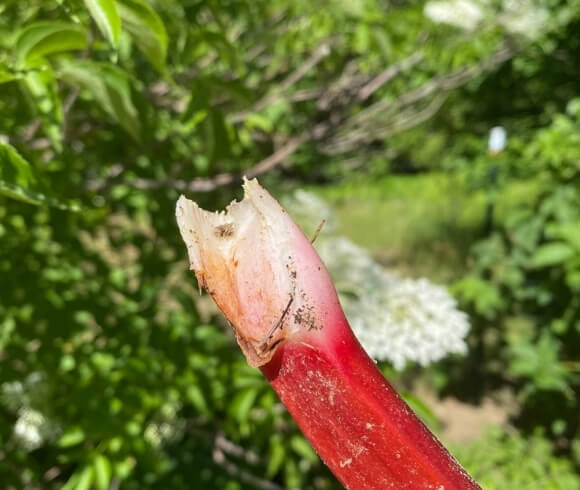
Should there be a tendency for the it feeling as though you are pulling up the entire plant, roots and all, make sure you tamp or pack down the soil surrounding the plant & gently try the above method once again.
Once you’ve harvested your rhubarb, cut off the leaf end of the plant (composting them), trim the bottom of the stem where it meets the plant, and wash the stems. Your rhubarb is now ready to use!
There you have it! Harvesting rhubarb & more specifically knowing how & when to harvest your rhubarb will have you enjoying this flavorful veggie in so many ways!
Love, Light, & Laughter ~

MAY BE OF INTEREST
Propagating Herbs From Cuttings

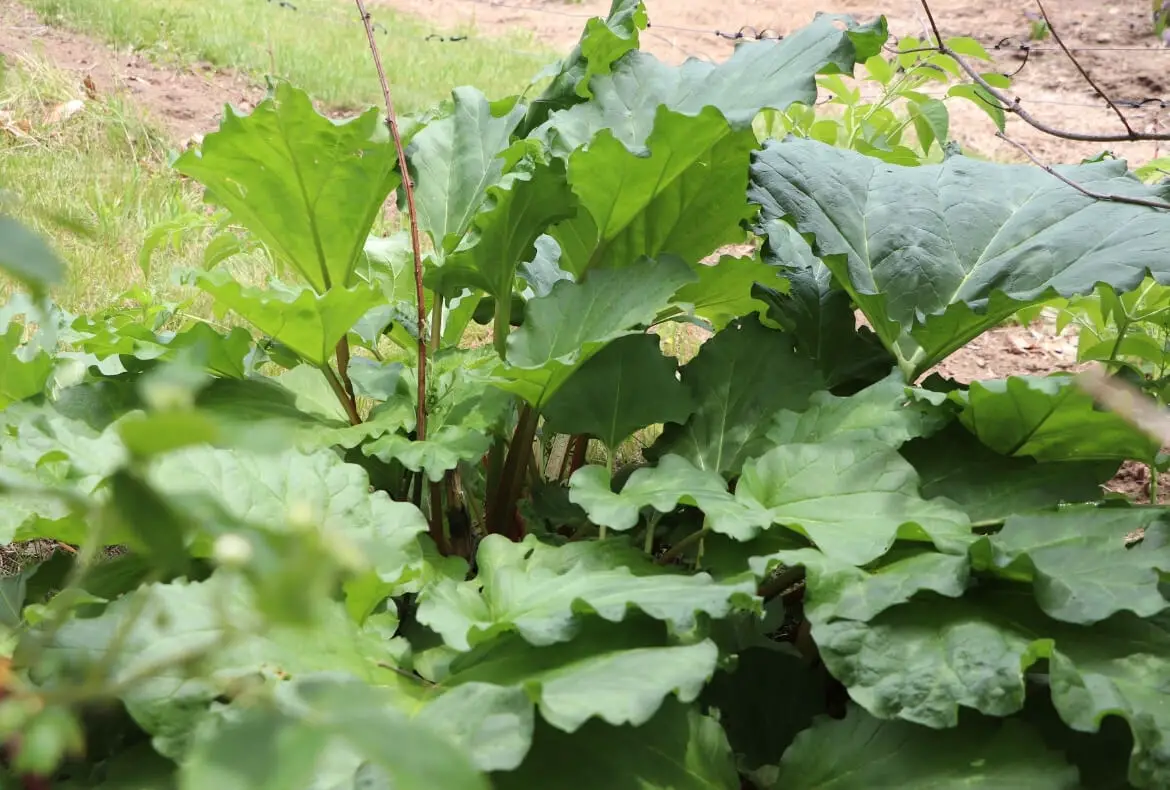

21 comments
Thank you for this information. It brings back many happy childhood memories of rhubarb pies my mom used to make. Apartment living does not allow me the opportunity to garden at all nor is it something I enjoy but I learn so much from your posts I look forward to reading more.
I’d love to try growing rhubarb! Currently, I don’t have the space for it. However, when I expand my garden area I’ll plan a spot for it.
Wow, thank you for sharing all of these tips!! I would love to get into gardening someday when I have a bigger backyard.
Looks great! I have more of a brown thumb, so I know very little about growing anything, lol.
Wow, I would not have known to wait at least 2 years to harvest. What helpful information!
I am dreaming of a Rhubarb pie, now!
I love rhubarb. They reminded my of my childhood. Thank for the info. Do you know if the leaves are also toxic for dogs? I’d love to start growing some. Thanks
Hi Cecile~
Yes they can be toxic to both dogs and cats & can cause vomiting, diarrhea, and mouth irritations. That being said, I’ve been growing it for almost 17 years with my furry friends and they’ve never bothered with it.
Thanks for reading!
I tried growing rhubarb once. I picked a sunny place, but I still don’t think it was sunny enough. It never came in. Might have to try it again!
This is great info to know…I am already planning my garden for next year so this is great timing!
Thanks for sharing your knowledge. I had rhubarb pie years ago and loved it! I had a great garden when living in Texas, but have found it difficult to grow vegetables here in Arizona as I don’t have a sprinkler/drip system. I am anxious to move back to Texas! Anyway, hope to add rhubarb to my list of vegetables to grow in the future. I am sure I subscribed last year, but haven’t been receiving your blog articles; will subscribe again!
Thanks so much, Roselyn!
I had no idea it took rhubarb three years to mature sufficiently for harvesting. Very informative article!
We always had rhubarb plants in the garden growing up! Great tips and information on how to grow and harvest it! Strawberry rhubarb pie is one of our favorites in my house!
I love rhubarb, I may need to plant some.
I love rhubarb!
Oh, I needed this post! LOL…. There was a time when I didn’t even know what rhubarb looked like or where to find it. My father-in-law had asked me to make him a rhubarb/strawberry pie…… I am saving your post for future reference.
I’ve never had rhubarb but now I wanna try it! I definitely wouldn’t have guessed that it’s a vegetable lol.
Hi and Happy July 4th Weekend. Pinned this post tom gardening board. Love sustainable ideas. My shares this week at Dare to Share are #71 and #72. Enjoy!
Great tips! I actually did not know rhubarb was a perennial. I love the details you provided about when it’s ready to be harvested. Thanks!
I am going to think about adding rhubarb to on of my above ground beds sometimes we do get a gentle freeze so this would be perfect along side my eggplant. Thank you for sharing your insight!